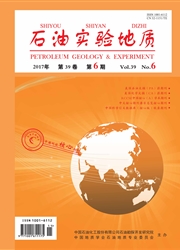

 中文摘要:
中文摘要:
依据大量地震勘探资料,对准噶尔盆地西北缘乌夏断裂带的构造特征进行了系统研究,并将其构造演化划分为碰撞前陆盆 地、前陆盆地逆冲推覆、陆内拗陷逆冲褶皱、陆内拗陷抬升剥蚀和覆盖定型5 个阶段.在此基础上,采用构造物理模拟实验方法 对研究区典型剖面晚石炭世以来的构造演化进行了正演模拟,取得了与实际地质情况较高的吻合度.模拟结果表明,乌夏断裂 带经历了由前陆盆地“前展式”逆冲向陆内拗陷“后展式”逆冲的转变.同时,实验结果进一步证实, NW-SE 向挤压应力场的控 制是乌夏断裂带形成、演化的根本原因,其主要受控于板块活动及造山带、边界控盆断裂的活动等关键因素.
 英文摘要:
英文摘要:
The tectonic characteristics of the Wuxia fault belt in the northwestern margin of the Junggar Basin were systemically studied based on a large number of 3D seismic data. The study area has experienced five tectonic evolution periods, including the collision of foreland basin, thrust-nappe structure of foreland basin, thrusting fold of interior depression, uplift and denudation of interior depression, and cover setting. The forward modeling of the tectonic evolution of some typical profiles ever since the Late Carboniferous fit well with actual geological conditions. The results showed that the Wuxia fault belt transformed from the thrust with piggy back in foreland basin to thrusting with overstep in the interior depression. Experimental results also indicated that the formation and development of Wuxia fault belt were mainly controlled by the NW-SE oriented compressive stress field, which was mainly affected by some key factors such as plate activities, orogenic belts, and frontier basin-controlling faults.
 同期刊论文项目
同期刊论文项目
 同项目期刊论文
同项目期刊论文
 期刊信息
期刊信息
